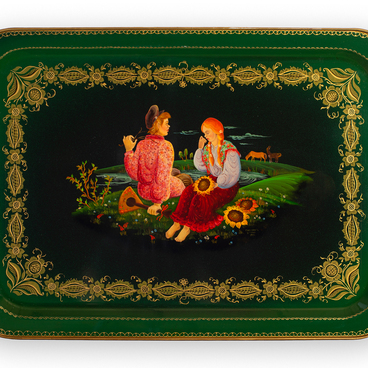“Flower Wreath” is a tray that was created by Agrippina Vasilyevna Afanasyeva (1913–2004). She was the oldest master of the Nizhny Tagil tray painting art who had contributed greatly to its revival. On this round tray, the artist depicted a wreath made up of seven Nizhny Tagil roses of various colors. The painting is characterized by ornateness and lightness thanks to the rounded petals, depicted without sharp lines and angles.
Red, orange, and pink flower buds are framed by smaller flowers and leaves, all coming together to form a harmonious composition. Agrippina Afanasyeva designed the composition in such a manner that one half of each flower was light and the other dark. The perimeter of the base is framed by a brushstroke trefoil pattern. The olive-green background is typical of the artist’s later works.
Agrippina Afanasyeva began studying the traditional Nizhny Tagil painting art when she was still a teenager. In the first half of the 20th century, during a time of war and manufacturing crisis, the artistic crafts in the Urals experienced a decline. This was also true for the tray painting art. The artistic and technical quality of the trays deteriorated.
When the Emalposuda (Enamelware) factory was opened in 1957, trays began to be produced using the stamping technique. To overcome the crisis in tray painting, there was an attempt to master the Zhostovo tradition and introduce it into the local craft. As a result, a new style appeared, the so-called “Moscow painting”, which was a simplified version of the Zhostovo painting created by Nizhny Tagil residents. This style remained popular until the mid-1970s.
It took a lot of effort by researchers and artists to revive the Ural tray painting art. This process was greatly facilitated by the artists who mastered the traditional two-color brushstroke technique. Agrippina Afanasyeva not only had the required artistic skills but also managed to pass them on to young artists.
Vasily Alexeyevich Baradulin, a researcher of Ural painting and a Moscow art historian, described the artist’s contribution in the following manner “In fact, in 1976, Grandma Grunya [Agrippina Afanasyeva] became a mentor for the entire young generation of Nizhny Tagil artists of the 1970s–1990s.” The famous craftswoman from Nizhny Tagil influenced the development of over 200 artists.




